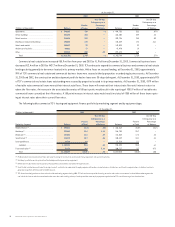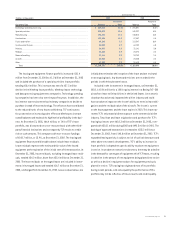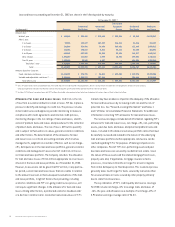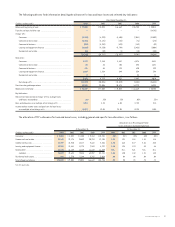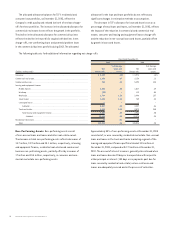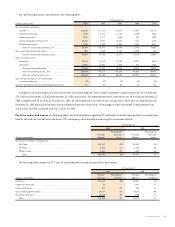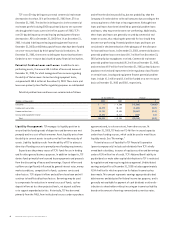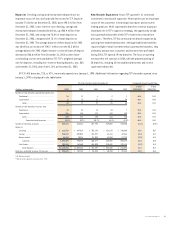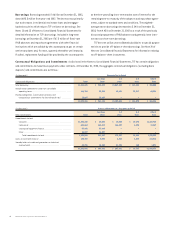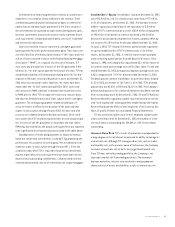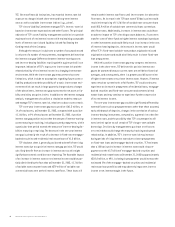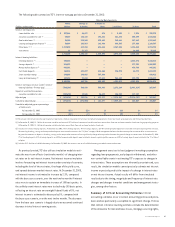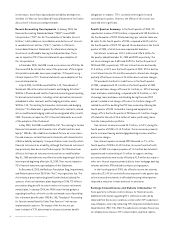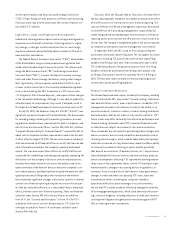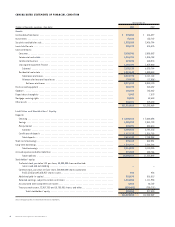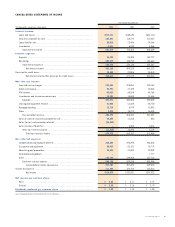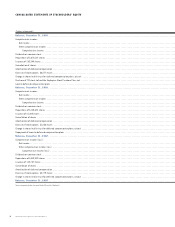TCF Bank 2003 Annual Report Download - page 46
Download and view the complete annual report
Please find page 46 of the 2003 TCF Bank annual report below. You can navigate through the pages in the report by either clicking on the pages listed below, or by using the keyword search tool below to find specific information within the annual report.
44 TCF Financial Corporation and Subsidiaries
TCF, like most financial institutions, has material interest rate risk
exposure to changes in both short-term and long-term interest
rates as well as variable interest rate indices (e.g., prime).
TCF’s Asset/Liability Committee manages TCF’s interest-rate risk
based on interest rate expectations and other factors. The principal
objective of TCF’s asset/liability management activities is to provide
maximum levels of net interest income while maintaining acceptable
levels of interest rate risk and liquidity risk and facilitating the
funding needs of the Company.
Although the measure is subject to a number of assumptions and
is only one of a number of measurements, management believes that
the interest rate gap (difference between interest-earning assets
and interest-bearing liabilities repricing within a given period) is an
important indication of TCF’s exposure to interest rate risk and the
related volatility of net interest income in a changing interest rate
environment. While the interest rate gap measurement has some
limitations, which include no assumptions regarding future asset or
liability production and the possibility of a static interest rate envi-
ronment which can result in large quarterly changes due to changes
of the above items, interest rate gap represents the net asset or lia-
bility sensitivity at a point in time. In addition to the interest rate gap
analysis, management also utilizes a simulation model to measure
and manage TCF’s interest rate risk, relative to a base case scenario.
TCF’s one-year interest rate gap was a positive $161.3 million, or
1% of total assets, at December 31, 2003, compared with a positive
$1.1 billion, or 9% of total assets at December 31, 2002. A positive
interest rate gap position exists when the amount of interest-earning
assets maturing or repricing, including assumed prepayments, within
a particular time period exceeds the amount of interest-bearing lia-
bilities maturing or repricing. The decrease in the one-year interest
rate gap is primarily the result of a decrease in fixed-rate mortgage-
backed securities and residential real estate loans of $1.5 billion.
TCF’s balance sheet is generally positioned to benefit from rising
interest rates due to a positive interest rate gap position. TCF would
also likely benefit from an increase in interest rates as this might
signify that economic conditions are improving. The favorable impact
of an increase in interest rates on net interest income would be par-
tially diminished by the fact that at December 31, 2003, $1.7 billion
of variable rate consumer loans and $379 million of variable rate
commercial loans were at their interest rate floors. These loans will
remain at their interest rate floors until interest rates rise above the
floor rates. An increase in the TCF base rate of 50 basis points would
result in the repricing of $1.2 billion of variable rate consumer loans
and $303.9 million of variable rate commercial loans currently at
their floor rates. Additionally, increases in interest rates could have
an adverse impact on TCF’s checking account balances, if customers
transfer some of these funds to higher interest rate deposit products
or other investments and would likely result in an increase in the cost
of interest-bearing deposits. An increase in interest rates would
affect TCF’s fixed-rate/variable-rate product origination mix and
origination volumes and would also likely result in slower fixed-rate
loan prepayments.
While this positive interest rate gap may compress net interest
income in the short-term, TCF believes this positive interest rate
gap to be warranted because current rates are well below historical
averages, and consequently, there is a greater possibility over time
of higher interest rates versus lower interest rates. However, if interest
rates remain at current levels or fall further, TCF could continue to
experience an increase in prepayments of residential loans, mortgage-
backed securities and fixed-rate consumer and commercial real
estate loans and may continue to experience further compression
of its net interest income.
The one-year interest rate gap could be significantly affected by
external factors such as prepayment rates other than those assumed,
early withdrawals of deposits, changes in the correlation of various
interest-bearing instruments, competition, a general rise or decline
in interest rates, and the possibility that TCF’s counterparties will
exercise their option to call certain of TCF’s longer-term callable
borrowings. Decisions by management to purchase or sell assets
or to retire debt could change the maturity/repricing and spread
relationships. In addition, TCF’s interest-rate risk may increase
during periods of rising interest rates due to slower prepayments
on fixed-rate loans and mortgage-backed securities. TCF estimates
that a 100 basis point increase in interest rates would slow pre-
payments on the $2.7 billion of mortgage-backed securities and
residential real estate loans at December 31, 2003 by approximately
$328.8 million, or 49%. A slowing in prepayments would increase the
estimated life of the mortgage-backed securities and residential
real estate loan portfolios and may adversely impact net interest
income or net interest margin in the future.


